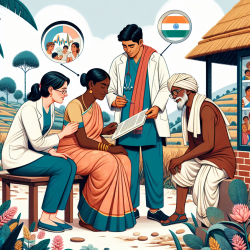Introduction
Perinatal health is a crucial aspect of maternal and child well-being, particularly in regions with high health risks. A recent study titled Perinatal risk and the cultural ecology of health in Bihar, India provides insightful data on how traditional and biomedical practices coexist in Bihar, India. This blog aims to explore how practitioners can leverage these findings to enhance their practice and encourage further research.
Understanding the Cultural Context
Bihar, India's most rural and poorest state, presents a unique cultural ecology where traditional and biomedical health practices coexist. The study documents various health-related beliefs and practices during pregnancy and postpartum, revealing a complex interplay between traditional rituals and modern medical recommendations.
Traditional practices such as the Chhathi ritual and taboos against the evil eye are deeply embedded in the local culture. These practices often aim to mitigate perceived risks, both physical and supernatural. For instance, the use of amulets and specific rituals during eclipses are believed to protect against harm.
Risk Aversion vs. Health Promotion
The study highlights that most health-related practices in Bihar are aimed at risk aversion rather than health promotion. During pregnancy, practices are primarily focused on avoiding risks such as miscarriage and birth complications. Postpartum, the focus shifts to both risk aversion and health promotion, with practices like immediate breastfeeding and skin-to-skin contact aligning with biomedical recommendations.
Implications for Practitioners
For practitioners, understanding the coexistence of traditional and biomedical practices is crucial for effective health interventions. Here are some strategies to consider:
- Respect and Incorporate Traditional Practices: Recognize the social and cultural significance of traditional practices. Use them as a platform to introduce biomedical recommendations, ensuring they complement rather than conflict.
- Community Engagement: Engage local health activists and religious leaders in health education efforts. Their influence can be pivotal in promoting biomedical practices within the framework of traditional rituals.
- Focus on Risk Communication: Educate communities about the benefits of health-promoting practices, emphasizing their role in risk reduction.
Encouraging Further Research
The study underscores the need for further research into the integration of traditional and biomedical practices. Future studies could explore how these practices impact health outcomes and how they can be optimized for better efficacy.
Practitioners are encouraged to conduct localized research to understand the specific cultural contexts of the populations they serve. Such research can inform tailored interventions that respect cultural beliefs while promoting health.
Conclusion
The insights from the study on perinatal health in Bihar offer valuable lessons for practitioners worldwide. By understanding and integrating cultural practices with biomedical recommendations, practitioners can enhance the effectiveness of health interventions and improve outcomes for mothers and children.
To read the original research paper, please follow this link: Perinatal risk and the cultural ecology of health in Bihar, India.










